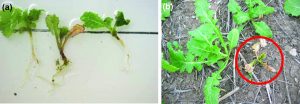Other names: Seedling blight, Seedling hypocotyl rot
Damping-off is usually caused by the fungus Rhizoctonia solani. However, other fungi including Fusarium spp., Pythium spp., Phytophthora spp. and Alternaria spp. can also cause damping-off. Symptoms and crop management are similar for all these pathogens, so they are grouped together and referred to as ‘damping-off’.
All species are common inhabitants of the soil and cause damage when conditions are not ideal for early seedling growth. Problems are usually seen when seed is sown dry, close to the autumn break (within a couple of weeks of a normal break) or if weather conditions become cool and damp. Yield loss is unusual unless plant numbers are severely reduced or patchy establishment occurs.
What to look for
Damping-off can produce many symptoms ranging from pre-emergence rot (failure of plants to emerge) to post-emergence damping-off (plants emerge and collapse at ground level). If affected plants survive, they are normally stunted and may flower and mature prematurely.
Once past the seedling stage canola plants are not adversely affected by damping-off. Both pre- and post-emergent damping-off occur in patches and affected areas can spread quickly during cold, wet conditions. Leaves of plants affected by post-emergent damping-off may become discoloured, turning orange, purple and/or chlorotic. In some cases, the tap root is dark in colour and shrivelled at ground level. These symptoms should not be confused with insect damage where root or stem tissue has been removed.
Damping-off fungi are soil-borne and survive in the soil by forming resistant resting structures when no host is present. These resting structures germinate with the break of the season and the fungi grow through the soil until they find a susceptible host plant. Seeds become vulnerable to attack as soon as they begin to germinate. Once in the plant, the fungi multiply causing decay that damages or kills the seedling. Damping-off fungi are usually only able to infect young succulent tissue. At the two to four leaf stage roots of canola plants become woody enough to withstand further infections. Therefore, most damage occurs when wet and cold weather slows plant growth. Temperature and soil moisture affect disease development. Loose, cold and dry soils favour Rhizoctonia solani, while cold damp soils favour Fusarium spp. and wet, heavy soils favour Pythium spp.

(a) Symptoms of rhizoctonia damping-off on seedling canola. (b) Infected seedlings that if survive may be stunted and flower prematurely.
Photo: S. Marcroft
Management
- Yields are only affected when plant numbers are severely reduced. If seedling loss is uniform throughout the crop, surrounding plants can often compensate by growing larger. If seedling loss is patchy and large areas die, then re-sowing may be required.
- Damping-off fungi will germinate with the opening rains of the season. Once they have germinated they are very successfully controlled by soil tillage. Therefore dry-sown or crops sown very close to the opening rains may be more severely affected. If crops are re-sown the sowing tillage will generally control the fungi.
Please note: This book is also available on AppleBooks


